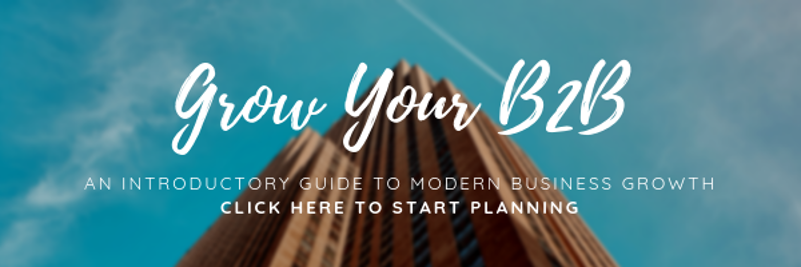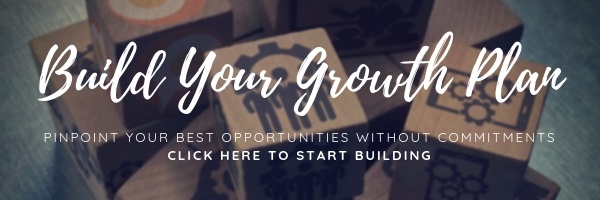We're all aware of the five stages of business growth (Development, start-up, growth, expansion, and exit), but how does one help their business locate the optimal time for exiting one and entering the next? What can you do as a business leader to ensure you get from one to the next?
As the leader of a growth agency and a business owner who bootstrapped my company from the ground up, I have ideas about when it makes sense to invest, where to put your $ first, so it works for you, and how to identify losers, so you can pivot without risking everything.
Services that Accelerate Growth
We built 6 programs designed to help businesses at varying stages accelerate their growth. They include:
- Sales Infrastructure Implementations:
Implement a modern CRM or modernize an existing one - This will help you automate data entry and other cumbersome tasks that weigh down your sales process, while giving upper management the ability to make better decisions about investments in sales or marketing (Download the Hubspot CRM Implementation Guide here) - Sales Enablement
Growth hacking your sales outcomes with data-driven collateral - This is where marketing leverages hard data to determine how to improve collateral and overall sales performance (what is "Sales Enablement?") - Website Development
Your website is the most important part of your online growth strategy. With a Growth Driven Design website, you put data first, and won't leave its success up to chance (what is "Growth Driven Design?") - Inbound Lead Generation & other marketing
Inbound provides a steady flow of leads, helping you create predictability to your sales pipeline. It's what we're most famous for, but most businesses we talk to are not ready for this type of investment (what is "Inbound Marketing?") - Sales & Marketing Alignment
Once you have established clear, objective benchmarks for both sales and marketing, and can easily measure outcomes, forging black-and-white terms of engagement is critical to ensuring both sides contribute to your growth. - Sales & Business Coaching
Often, the best step you can take is hiring somebody to coach you through the more challenging times, to help you navigate the unknown. This applies to big business decisions as well as helping your teams transition to working with inbound leads vs cold leads.
Within those walls, you'll find other programs, such as PR, video production, social media, SEO, technology consulting, and project management.
They're not all going to make sense at each of the 5 stages of growth, so I'll highlight which ones apply where, and to what degree it makes sense to engage based on stage.
Get started on your Growth Planning with this introductory guide:
Stage 1: Development
This is the phase of your company where you're trying to understand what it is that your business does best, how you'll make money, and where and how you'd like to initiate lift-off.
It's a challenging stage, because there's typically nobody around to help you get it all together or pull the trigger.
The trick here is to build up the confidence and resources necessary to take the first step forward.
The first big mistake I see a lot of you making in this stage is waffling over details that we'll never know are a good idea until you launch. The second is skipping the business plan... taking the time to understand your market through research and TALKING to people about your services.
- Sales Infrastructure Implementations
- Sales Enablement
- Website Development
- Inbound Lead Generation & other marketing
- Sales & Marketing Alignment
- Sales & Business Coaching
One of the best ways to accelerate this process is to beta test. Put out an idea, then sell it as a free or significantly discounted service. Get a couple of test subjects in-house, then validate or disprove your ideas. Pivot, update, and test again until you feel confident in your ability to scale.
Don't be afraid to take some criticism. Don't feed your test subjects with answers you want to hear. (source: https://www.entrepreneur.com/article/270340)
It may also make sense to hire a business coach to help you through these critical decisions. The point is, don't internalize everything!
Stage 2: Start-up
After you launch, don't expect everything to go as planned. In fact, prepare yourself for break-neck pivoting and retooling of your ideas, processes, and procedures.
This is the riskiest time for any business, because you're putting money into it, and a significant portion of you will fail in this phase.
But if you're paying attention to your successes and failures, and all of the reasons why they are what they are, you'll be able to pivot with confidence. The big key here is to establish baseline metrics for every investment you make... whether it be sales, marketing, or customer service.
You should be able to determine whether a new investment will be a good idea by looking at your historical data.
- Sales Infrastructure Implementations
- Sales Enablement (not enough data or volume yet)
- Website Development
- Inbound Lead Generation & other marketing (pivots are expensive)
- Sales & Marketing Alignment
- Sales & Business Coaching (probably both)
Accelerate your learning curve by implementing sales infrastructure that shows the full story of your sales funnel, while elevating insights to sales when and where they need them the most.
If you're going to invest in marketing at this stage, I suggest starting with the most critical pieces, such as your website. Anything outside of that should be small, making sure that you have the ability to calculate and measure ROI... not marketing KPIs such as impressions, visits, or leads generated... actual ROI. To do this, you need sales infrastructure!
Stage 3: Establish & Grow
Exiting the start-up phase means that you're generating consistent income and adding new clients on a regular basis.
The challenges here often relate to your ability to delegate as you grow.
This means having other people (not you) handle the marketing, sales, and general administration of your services.
Today, one of the best ways to accelerate through this phase is with 3rd party services... agencies that exist for one purpose. The reason being that you won't have to take on significant overhead to apply significant expertise and resources.
Find services that are willing and able to consolidate a lot of complex tasks. This will ensure that they are all operating together and working toward common goals, and you can hand off huge time-suckers to people who do nothing but perform those types of services.
Additionally, you should have the ability to establish meaningful baseline metrics and goals. And as long as you've invested in the ability to see and control sales outcomes from the managerial level, you can start growth hacking your sales collateral, and invest in inbound lead generation.
But don't stop there. To ensure your sales and marketing teams are on the same team as each other, execute a measurable, objective SLA between them, holding both sides accountable to outcomes that favor your growth plans.
- Sales Infrastructure Implementations
- Sales Enablement
- Website Development
- Inbound Lead Generation & other marketing
- Sales & Marketing Alignment
- Sales Coaching
Stage 4: Expansion
After you've established a repeatable, scalable offering, and found a spot in the market, you may be getting the itch to expand. It's a good itch; one that I highly recommend.
You already have the recipe for success. Now you can reach more markets and work to stay ahead of competitors as you grow.
To accelerate your expansion, I suggest thinking about to some of the ideas discussed related to the start-up and growth stages.
- Sales Infrastructure Implementations
- Sales Enablement
- Website Development
- Inbound Lead Generation & other marketing
- Sales & Marketing Alignment
- Sales & Business Coaching
CONCLUSION:
Growing takes energy. You should always expect to put something into the tank when it comes to growing your business. Our ideas on the subject put transparency and accountability first.



